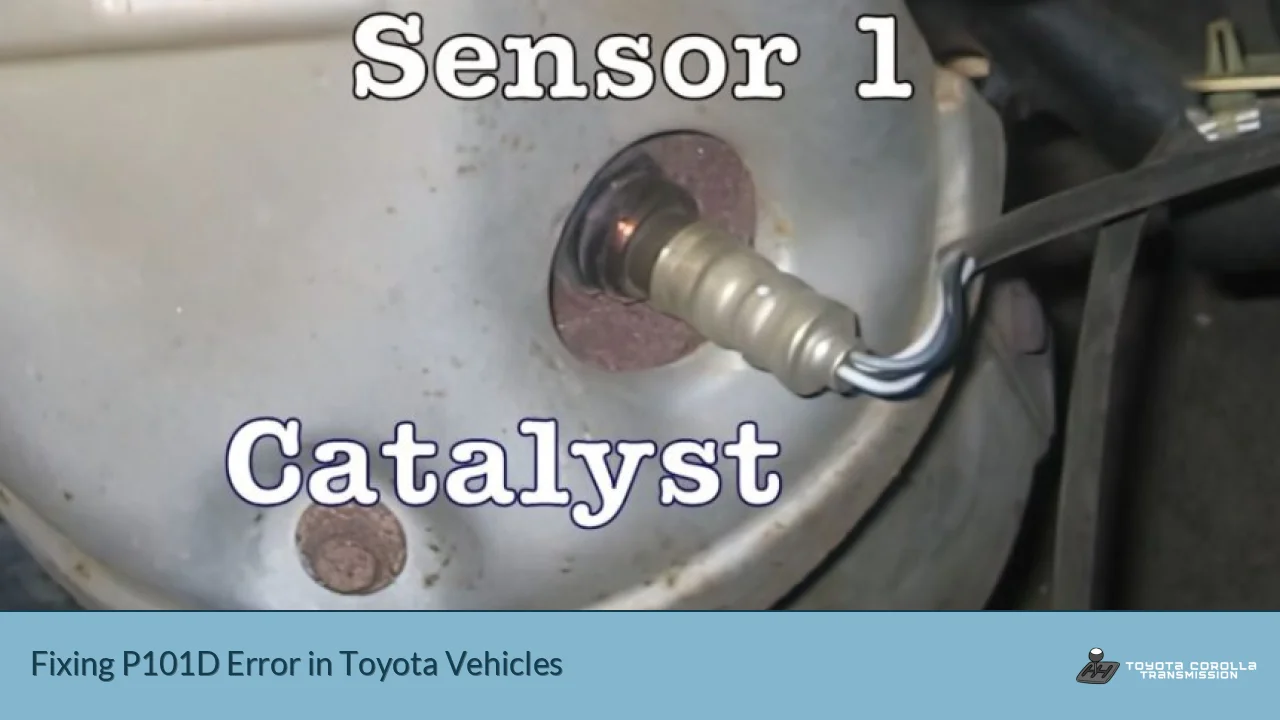The P101D error code in Toyota vehicles indicates a malfunction in the heater circuit of the heated oxygen sensor (HO2S) 1 on bank 1. This issue can lead to various performance problems and increased emissions if left unaddressed. Understanding the causes, symptoms, and solutions for this error code is crucial for maintaining your Toyota’s optimal performance and fuel efficiency.
| Aspect | Details | Impact |
|---|---|---|
| Location | Bank 1, Sensor 1 | Affects engine’s primary oxygen sensor |
| Function | Heater Circuit | Ensures rapid sensor operation |
| Consequence | Stuck On | Potential damage to sensor and inefficient fuel mixture |
Understanding the P101D Code
What Does P101D Mean?
The P101D code specifically refers to a problem with the heater circuit of the first oxygen sensor (also known as the upstream sensor) on bank 1 of the engine. In Toyota engines, bank 1 typically refers to the side of the engine that contains cylinder number 1. The “stuck on” indication suggests that the heater circuit is continuously active, which can lead to premature sensor failure and inaccurate readings.
The Role of Oxygen Sensors
Oxygen sensors play a critical role in engine management and emissions control. They monitor the oxygen content in the exhaust gases, providing crucial data to the Engine Control Module (ECM) for adjusting the air-fuel mixture. The heater circuit in modern oxygen sensors is designed to bring the sensor to operating temperature quickly, ensuring accurate readings from a cold start.
Causes of the P101D Error
Several factors can contribute to the P101D error code:
- Faulty oxygen sensor: The sensor itself may be defective, particularly if it’s an older vehicle.
- Wiring issues: Damaged or corroded wiring in the heater circuit can cause the system to malfunction.
- ECM problems: In rare cases, the Engine Control Module may be misinterpreting signals or failing to control the heater circuit properly.
- Blown fuse: A blown fuse in the oxygen sensor heater circuit can trigger this code.
Symptoms Associated with P101D
While the check engine light is the most obvious indicator, other symptoms may include:
- Decreased fuel efficiency: A malfunctioning oxygen sensor can lead to an improper air-fuel mixture, reducing fuel economy.
- Rough idling or hesitation: The engine may run roughly or hesitate during acceleration due to incorrect fuel adjustments.
- Increased emissions: Improper fuel mixture can result in higher levels of harmful emissions.
Diagnosing and Fixing the P101D Error
Diagnostic Steps
- Use an OBD-II scanner: Confirm the P101D code and check for any additional related codes.
- Inspect wiring and connections: Look for any visible damage, corrosion, or loose connections in the oxygen sensor wiring.
- Check the fuse: Ensure the fuse for the oxygen sensor heater circuit is intact.
- Test the oxygen sensor: Use a multimeter to check the resistance of the heater circuit and the sensor’s output voltage.
Repair Options
- Replace the oxygen sensor: If the sensor is faulty, replacing it with a new, high-quality sensor is often the best solution.
- Repair wiring: If wiring issues are found, repair or replace the damaged sections.
- Update ECM software: In some cases, a software update for the Engine Control Module may resolve the issue.
It’s important to address the P101D code promptly to prevent potential damage to the catalytic converter and ensure optimal engine performance.
Preventive Measures
To avoid future occurrences of the P101D error:
- Regular maintenance: Follow Toyota’s recommended maintenance schedule.
- Use quality fuel: Poor quality fuel can lead to sensor contamination.
- Address check engine lights promptly: Early intervention can prevent more serious issues.
FAQs
What causes the P101D code in Toyota vehicles?
The P101D code is typically caused by a malfunctioning oxygen sensor heater circuit, often due to a faulty sensor, wiring issues, or ECM problems.
Can I drive with the P101D code?
While you can drive short distances, it’s not recommended for extended periods as it can lead to decreased performance and potential damage to other components.
How much does it cost to fix a P101D error?
Repair costs can range from $100 to $500, depending on whether you need to replace the oxygen sensor or if there are more complex wiring issues.
Will the P101D code clear itself?
The code will not clear itself. It needs to be addressed and then cleared using an OBD-II scanner after the repair is completed.
How often should oxygen sensors be replaced?
Most manufacturers recommend replacing oxygen sensors every 60,000 to 90,000 miles, but this can vary based on driving conditions and vehicle model.

